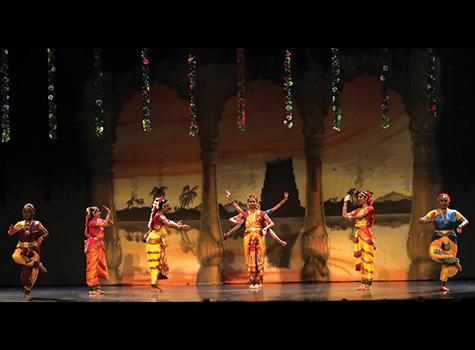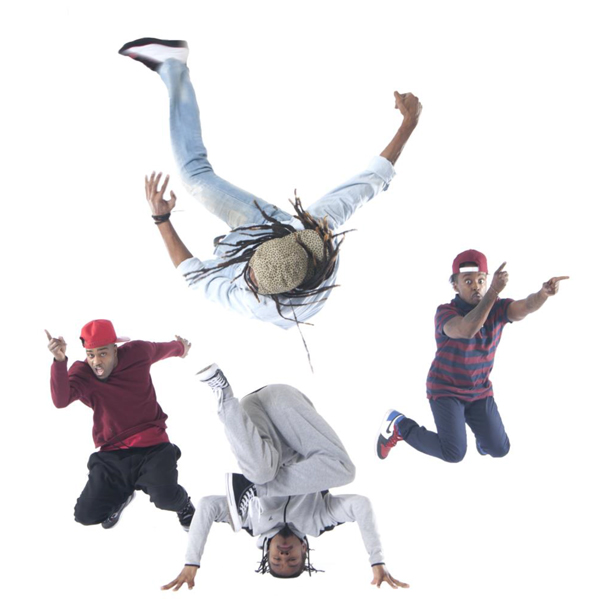
One way that I mark summer is the American Dance Festival (ADF) season, which starts at around the time schools get out and ends mid-summer with lazy days of August ahead. Time sure does seem to fly as the 86th annual ADF is coming to a close at press time. It’s been full, exciting, provocative, and impressive.
Since last month’s column, I saw Dorrance Dance, Paul Taylor Dance Company, Cleo Parker Robinson Dance Ensemble, Pilobolus, the Faculty Concert, Eiko Otake, Rennie Harris Puremovement American Street Dance Theater, Malpaso Dance Company, and A.I.M. by Kyle Abraham. I will see Footprints, the closing show, after press time.
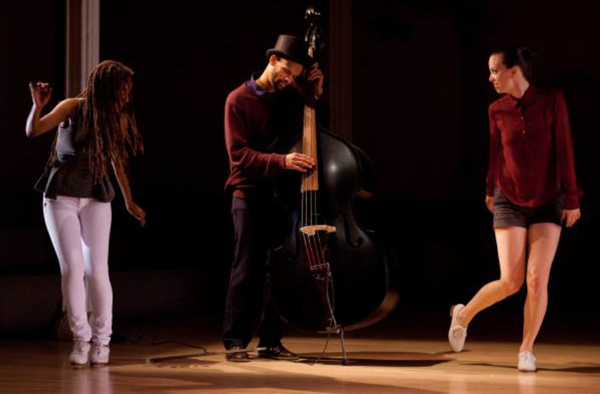
I first saw tap dancer, MacArthur Fellow, and Chapel Hill native Michelle Dorrance performing solo at ADF 2018. This year, her Dorrance Dance performed the 2013 SOUNDspace. I enjoyed the lighting design’s contrast and low aim to highlight the tapping – and not just in tap shoes but sometimes in socks. A strong bass line accentuated the rhythms. I was reminded of when ADF, some years ago, put on a special program that showed unity among kathak, tap, and flamenco; I hope that they will offer such a feast again in the next few seasons.
The whole season is dedicated to modern dance pioneer Paul Taylor, and it was fitting that Paul Taylor Dance Company danced one new dance and two older ones. They had two programs; I saw program A, which included the 1961 Aureole that my elementary school-aged daughter gleefully described as having “sharp, crisp movements and running leaps”; I liked the happy white costumes. The 1963 Scudorama told the story of a day with a background of 5-layered clouds. The monochromatic (one in red, one in muted red, one in green, two in yellow, and three in black) costumes and vigorous, insistent music made me think of people awakening from a nightmare then making it through a day. I’ve seen the 2002 Promethean Fire several times and this was probably my favorite. This time, they had black costumes with curved dark purple stripes. Bach’s music beautifully complemented the strong and beautiful dance.
Cleo Parker Robinson Dance Ensemble, in early July, presented a sometimes poignant and sometimes joyful program of five dances. The solo Mourner’s Bench taught me some distressing history and was powerfully tragic in its realistic portrayal. The work derives from “the annihilation by the Ku Klux Klan of a mixed-race farming community in the rural South during Reconstruction. The dancer, sitting on the mourner’s bench, has recovered the body of a loved one from the devastated fields,” as the playbill describes. It is all the more remarkable that the dance premiered in 1947 by Talley Beatty, well before discussions of racial injustice were more common. Were that such unimaginable hateful acts fiction! But they’re not, and I’m thankful for such a powerful reminder. Uprooted: Pero Replantado was the final dance in five parts. It expresses, perhaps a bit simply, the story of undocumented immigrants in this country.
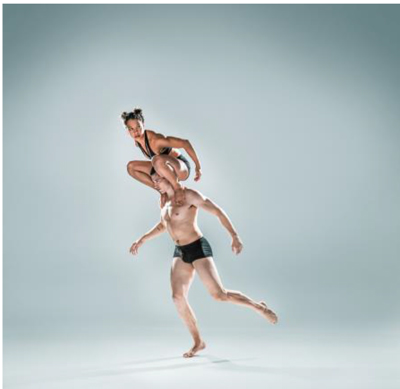
I first saw tap dancer, MacArthur Fellow, and Chapel Hill native Michelle Dorrance performing solo at ADF 2018. This year, her Dorrance Dance performed the 2013 SOUNDspace. I enjoyed the lighting design’s contrast and low aim to highlight the tapping – and not just in tap shoes but sometimes in socks. A strong bass line accentuated the rhythms. I was reminded of when ADF, some years ago, put on a special program that showed unity among kathak, tap, and flamenco; I hope that they will offer such a feast again in the next few seasons.
The whole season is dedicated to modern dance pioneer Paul Taylor, and it was fitting that Paul Taylor Dance Company danced one new dance and two older ones. They had two programs; I saw program A, which included the 1961 Aureole that my elementary school-aged daughter gleefully described as having “sharp, crisp movements and running leaps”; I liked the happy white costumes. The 1963 Scudorama told the story of a day with a background of 5-layered clouds. The monochromatic (one in red, one in muted red, one in green, two in yellow, and three in black) costumes and vigorous, insistent music made me think of people awakening from a nightmare then making it through a day. I’ve seen the 2002 Promethean Fire several times and this was probably my favorite. This time, they had black costumes with curved dark purple stripes. Bach’s music beautifully complemented the strong and beautiful dance.
Cleo Parker Robinson Dance Ensemble, in early July, presented a sometimes poignant and sometimes joyful program of five dances. The solo Mourner’s Bench taught me some distressing history and was powerfully tragic in its realistic portrayal. The work derives from “the annihilation by the Ku Klux Klan of a mixed-race farming community in the rural South during Reconstruction. The dancer, sitting on the mourner’s bench, has recovered the body of a loved one from the devastated fields,” as the playbill describes. It is all the more remarkable that the dance premiered in 1947 by Talley Beatty, well before discussions of racial injustice were more common. Were that such unimaginable hateful acts fiction! But they’re not, and I’m thankful for such a powerful reminder. Uprooted: Pero Replantado was the final dance in five parts. It expresses, perhaps a bit simply, the story of undocumented immigrants in this country.
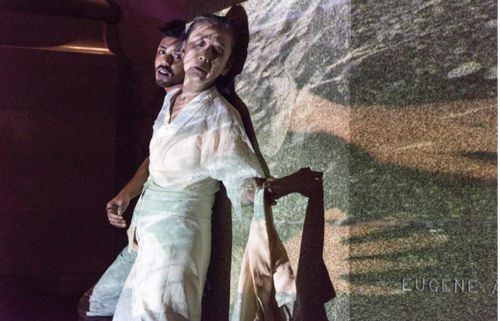
Though Eiko and Koma’s dances are characteristically quite deliberate and slow, either as a duo or separately, I quite enjoy their dance form, inspired by Japanese post-WW II avant-garde dance such as Butoh. Eiko Otake was at ADF in one of my favorite venues to really get up close with dance, the von der Heyden Studio Theater in the new Rubenstein Arts Center. She performed The Duet Project: Distance is Malleable. Meant to morph performance-to-performance, it includes varying local artists who accompany her; as she writes about this dance, “I work with a diverse group of artists, living and dead. Collaborators come from different places, times, disciplines, and concerns.” Though different themes are woven in, the leitmotif is of the recent death of Eiko’s mother. The emotion is palpable, including a calm recollection of traditional funeral rites as well as a primal scream and the flinging open of the theater’s doors, as if in search of the lost mother. The evening was a multimedia experience with art being made during the dance, a painting of a dress exhibited, and videos and painting shown outside of the theater.
One of my favorite performances of the season was an evening program entitled Funkedified by Philadelphia’s Rennie Harris Puremovement American Street Dance Theater. The 70-minute performance, with no intermission, was a powerhouse of energy with sometimes ten or more dancers on stage and a live band. Most of the music was theirs and had nods to James Brown and classic funk; they also had Bobby Womack’s Across 110th Street and a George Clinton number. The dance was spectacular and included a unique spin on break, hip hop, and street dance. The eight dances included ones with fun titles like Give the Drumah Sum, Soul Maggot, and Supa Josh & Crazy Sax.
Regarding venues, ADF’s shows were mostly on the Duke campus this year, especially in Reynolds Auditorium. While I missed the larger Broadway show-hosting venue of the Durham Performing Arts Center, I understand the desire to have more intimate venues. I always consider it a treat to be in the historic Carolina Theatre, where Rennie Harris performed.
A characteristic of ADF and modern dance in general that I cherish is the unexpected. ADF has had Cuban troupes before and so when I went to see Malpaso Dance Company, I thought I’d see bold, bright costumes to a driving beat. It turned out to be an evening of delicate and subtle dance, especially their final piece, the 1986 Tabula Rasa. I wish that there would have been a post-performance discussion as I wanted to engage the choreographer and dancers in questions of their unique pairings and separations, and wondered if they had interpersonal or – though I would not have asked – even political underpinnings.

If you get a chance to see Kyle Abraham, I hope that you will be lucky enough to get to meet him or at least hear what he has to say in a question and answer session. He comes across as brilliant while being humble and kind. His work is marked by strong scores, reflecting his musical background, and dramatic lighting. In his ADF show, he featured five dances. He performed a powerful solo in Indy, a 2018 dance that cleverly combined techno music with some light hip hop. He came on stage with fiercely rapid arm movements and continued on with exaggerated body and facial expressions. Even his costume, with frills behind, flowed nicely with the rhythm. Mediation: A Silent Prayer is a somber contemplation of police shootings of African American men such as Eric Garner, Michael Brown, and Trayvon Martin. Visual artist Titus Kaphar’s images of three big, blurred (but with sharp eyes) men form the background for a half dozen dancers. The music includes repetitive spoken word, mesmerizing and suitably troubling, including citing ages and backgrounds of the dead.
For more details, visit www.AmericanDanceFestival.org
Note: American Dance Festival logo and images courtesy of American Dance Festival and used with permission.

